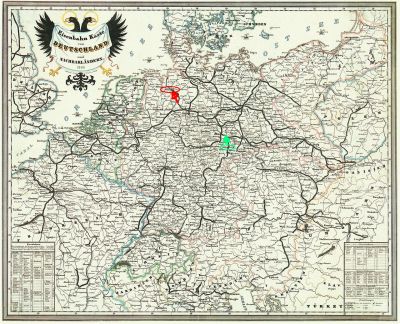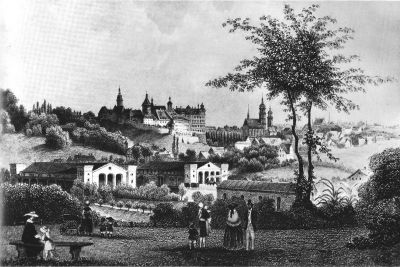Emigration
15
Farewells to Family
According to family lore, Julius’s two sisters and mother (actually step-mother as Julius’s mother died when he was 7 years old) cried that Julius’s leaving was like him dying – saying that they would never see him again. His step-mother gave him a little money and wished him well.
And, indeed Julius never saw or heard from his family again. According to family lore, after arriving in the USA and having earned money, Julius sent a letter with money back to his step-mother. But, he never received a reply. According to genealogy research, his step-mother died a little over a year after Julius immigrated to the USA.
How Much Time Did Julius Have to Travel to the port of Bremen (Bremerhaven)?
As shown in Chapter: Kosmos Passenger Manifest Observations, the Bark Kosmos, Bremen arrived at the Port of New York City on 22 April 1853. And, according to DIE MAUS Departures of emigration passages, the Kosmos for this 22 Apr 1853 Port of New York arrival departed from Bremerhaven on 9 Mar 1853. Therefore, from the time Julius received his permission to emigrate on 3 Feb 1853, Julius had 35 days to prepare and travel from his home in Fichtenhainichen to the Bremen and board the Bark Kosmos at Bremerhaven.
Information Source
DIE MAUS – A Project with the Bremen Chamber of Commerce and the Bremen Staatsarchiv (State Archive) maintains historical archives of documentation and databases of vessels in the Port of Bremerhaven. See Departures of emigration passages. http://212.227.236.244/auswanderung/abfahrtsdaten/passagen.php?s=s&v=Kosmos&lang=en
How Did Julius Travel From Fichtenhainichen to Bremerhaven?
We do not know how Julius traveled. It is not likely that Julius walked from Fichtenhainichen to Bremerhaven. What is known is that Germany was expanding their railway system at the time that Julius traveled to Bremerhaven. In 1845, there were already more than 2,000 km of railway line in Germany; and ten years later that number was above 8,000 km. The German railway system in 1849 is shown in the following map:

The green arrow is Altenburg and the red arrow is Bremen. By current day roads, this distance is about 430 km and as the crow flies about 230 miles.
Information Source
History of rail transport in Germany. Downloaded 21 Jan 2019 from https://en.wikipedia.org/wiki/History_of_rail_transport_in_Germany.
Altenburg Station
The original Altenburg railway train station opening ceremony was held on 19 Sept 1842 and it was the first station in the Ernestine duchies. The original train station was not located where it is today.

In above picture center is the passenger station, on the left is the freight yard. The Duchy of Saxe-Altenburg required the station to be built as close as possible to the Residenzstadt (royal palace) of Altenburg which is shown at the top of the hill behind the train station.
How Did Julius Afford Train Travel?
Family lore (See: Chapter: Was Julius a Stow-Away?) has that Julius came across the Atlantic as a stow-away. But as noted in Chapter: Kosmos Passenger Manifest Observations, Julius was not a stow-away on the ship. The version of the story that grandmother Kirmse told about Julius being a stow-away may be a clue as to how he got to Bremen. The story as told was that Julius stowed-away on the ship and when the conductor came through to get the tickets, Julius was hidden under the flowing skirts of one or more women travelers. What is strange about the story is that grandmother Kirmse referred to a “conductor” gathering the tickets. This sounds more like a train than a ship. Maybe this is how Julius made his way to Bremen.
What was Julius’s Destination?
The bark Kosmos passenger manifest says that Julius’s destination was Buffalo. This was a reasonable destination because after the completion of the Erie Canal in 1825, Buffalo became the western end of the 524-mile waterway starting at New York City. By the 1840s German-Americans made up one-third of Buffalo’s population. German was spoken and there were German newspapers, churches, businesses and industries.
Information Source
Abstracted from Wikipedia Buffalo, New York and Erie Canal.
